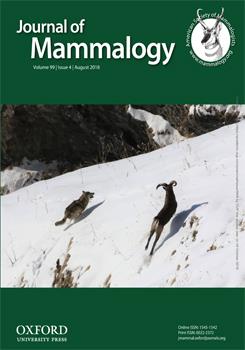Population genetic patterns can be affected by a number of factors, including life history characteristics and landscape features. Identifying general patterns of connectivity and key factors affecting these patterns is often central to effective ecological monitoring and management, particularly in areas with increasing urbanization. Examining patterns of connectivity and diversity of widespread and still abundant vertebrates, such as many cricetid rodents, can serve as a general indicator of habitat quality and connectivity. We investigated patterns of genetic diversity, differentiation, and population structure in 2 species of deer mice (
How to translate text using browser tools
1 June 2018
Genetic patterns in fragmented habitats: a case study for two Peromyscus species in southern California
Kelly A. Lion,
Stephen E. Rice,
Rulon W. Clark
ACCESS THE FULL ARTICLE

Journal of Mammalogy
Vol. 99 • No. 4
August 2018
Vol. 99 • No. 4
August 2018
landscape resistance
life history traits
microsatellites
Peromyscus
population genetic structure
road ecology




